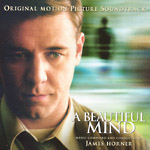In A Beautiful Mind James Horner associates genius with divine inspiration through his use of angelic choirs, a technique he employed in his earlier score to Brainstorm, a film that also dealt with a certain “higher knowledge”. Indeed, A Beautiful Mind’s “Closing Credits” track conjures up memories of the earlier film’s celestial visions. Horner also is adept at describing earthbound brain mechanics, as in the opening track “A Kaleidoscope of Mathematics”, with its rapid piano-driven ostinato representing complex mental processes.
Charlotte Church makes her film score debut in the song “All love can be”, based on a four-note dirge-like melody very reminiscent of Gorecki’s Symphony No. 3. Church, whose waif-like voice Horner describes as something caught between child and adult, also sings a sort of “heavenly” vocalise throughout many of the numbers, lending the music its slightly otherworldly feel. In fact, graced with beautiful harmonies and lush instrumentation, much of the music has a distinctly meditative quality. Even “Car Chase” never whips up the kind of kinetic energy you would expect, but instead creates tension by relentlessly repeating that four-note dirge motif. No, this certainly is not one of those pulse-pounding, blockbuster soundtracks, but it’s one that perfectly suits its film and on its own provides much pleasant listening.
































